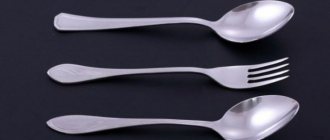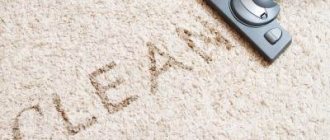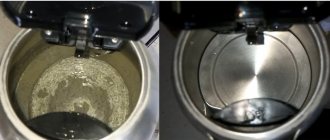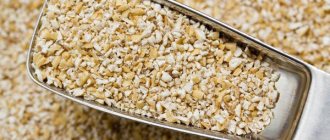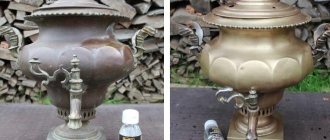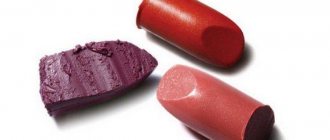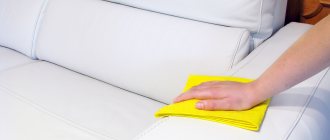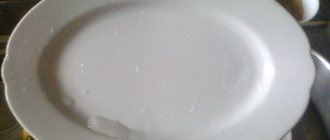Some housewives have stainless steel sinks installed in their kitchens, the popularity of which is growing every day. Kitchen utensils made from this material are in perfect harmony with other appliances and, with proper care, retain their original appearance. They are also considered more aesthetic, hygienic and practical.
But no matter how durable the sink is, stains, plaque and rust can form on it. And therefore, you need to identify the reasons that affect the appearance of the sink and find out with what means and methods you can remove dirt, while avoiding the formation of defects.
Methods for everyday cleaning of your sink
Kitchen sinks, regardless of the material they are made from, require daily maintenance. Usually this is a fairly simple procedure that housewives perform automatically after each use of the sink. After freeing the sink from dishes and food debris, wipe its walls and sides with a sponge soaked in detergent, then rinse with clean water and wipe dry. The usual “Fairy” or any of its analogues will work here as a cleaning product. The main thing is that the composition dissolves the fat remaining on the walls of the sink after washing dishes. The hard side of a dish sponge can deal with the beginning of limescale deposits on the walls of the sink, in the area of the mixer and drain during daily processing. The main thing is to wipe the surface dry after washing. And here we meet the first difference between the materials - even the smallest dried drop of water will be noticeable on the shiny surface of stainless steel. If you neglect wiping several times or do it not very carefully, and after a week you will have to rack your brains over how to clean the sink from plaque. But on sinks made of artificial stone, lime deposits are hardly noticeable at first. Therefore, it is not necessary to polish them until they shine after each use; they will still look decent.
Regular care
Due to constant exposure to water, grease and other sources of contamination, the surface of the sink may darken and become covered with an unflattering coating. To avoid such trouble, you need to take care of it daily.
Only daily care with detergents will keep the sink clean.
For regular cleaning you will need:
- detergent;
- sponge and rags;
- latex gloves.
Instructions for daily cleaning of the sink are simple:
- Apply cleaning agent to the surface . If you don’t have this on hand, you can replace it with dishwashing liquid.
For daily cleaning of the sink, any degreasing dishwashing detergent will do.
- Remove dirt . Wipe the sink thoroughly. For this, it is best to use the hard side of the sponge.
- Rinse off with water . Thoroughly rinse any remaining detergent with running water.
- Wipe dry . To do this, use a dry, soft cloth.
To ensure that there are no streaks left in the kitchen and bathroom sinks, they must be wiped dry
Preventative measures
To prevent a stainless steel sink from losing its original appearance, do not forget about preventive measures - they prevent the formation of stains on it. I will advise you a few simple steps:
- Minimum abrasives. Do not constantly clean the surface with powder substances containing abrasive particles. Firstly, they can cause minor scratches, and secondly, their price is much higher than conventional means at hand.
- Do not leave food residues in the sink. After washing dishes, always empty the sink of any leftover food. They provoke the formation of new stains that eat into the surface.
Do not leave dirty dishes in the sink overnight - this can cause unpleasant odors and stains.
- Do not use wire brushes. They may cause minor scratches.
- Regular polishing. To keep your sink shiny, treat it with vegetable or olive oil at least once every two weeks.
Comet
Comet is a cleaning product that does not contain chlorine or its compounds and is safe for hands. Comet is able to remove any contamination from any surface, of any complexity, even the most neglected. Perfectly cleans the kitchen sink of rust, limescale and other contaminants. This property determined its popularity in the kitchen.
Comet penetrates the surface of the sink and eats away stubborn grease. Comet kitchen cleaner contains chlorinol and an abrasive component. Detergent particles penetrate into the dirt and create foam, which simply removes it. This product should not be used on metal surfaces.
Removing stains
When it comes to household cleaning, hydrogen peroxide is becoming a popular choice. Not only does it clean and disinfect, it's an environmentally friendly alternative to chlorine bleach. If you have pets or small children, you may want to invest in a bottle of peroxide. To clean a stainless steel sink with peroxide:
Mix three parts wine vinegar with one part hydrogen peroxide. You don't need a lot of cleaner—start with three tablespoons of vinegar to one tablespoon of hydrogen peroxide. Dampen a soft cloth and wipe the sink. To remove stuck food and stubborn grease, use a nylon brush or pot scrubber. Again, avoid metal brushes, scrubbers, and sponges made from copper. Shine and remove scratches from stainless steel The next time you use lemon for cooking, save the leftovers for cleaning your stainless steel sink. Depending on how you used the lemon, cut it in half and rub the pulp side into the shell. Finally, to remove streaks and stains that often remain after cleaning a stainless steel sink, wipe the base of the sink with soda or olive oil. Pour some onto a paper towel or rag, then wipe the sink. Maintaining an attractive stainless steel sink Avoid harsh or abrasive cleaners. Abrasive cleaners can damage the surface of stainless steel, leaving scratches. Matte stainless steel perfectly hides scratches; polished steel, however, is also not easy to scratch. Test your cleaning products on an inconspicuous area of the sink before using. Always wash with the grain of the sink, not against it. Keep your sink clean. Dirt, food debris and grease that remain on the surface of a stainless steel sink can create difficult stains or damage the finish of the sink. Avoid cleaning products with bleach and chlorine. Stainless steel and chlorine bleach should not mix. Chlorine bleach ions react negatively on stainless steel. This can lead to oxidation, gray and yellow spots. Avoid metal brushes and sponges. Stainless steel is polished, so wire brushes may scratch the finish. Subsequent rusting contributes to the corrosion that forms on the surface of the stainless steel sink.
Removing stains from the sink
To be honest, even regular cleaning of the sink does not guarantee 100% removal of various contaminants. I will tell you how to clean the sink from dark stains that arise due to surface contact with oxidizing agents.
You can clean the sink using available products
4 products to remove dark plaque
If unpleasant dark spots have formed on the surface of the sink, it is not at all necessary to resort to the help of strong household chemicals. You can also cope with improvised means, such as:
- baking soda;
- starch;
- vinegar.
As a last resort, you can use standard bleach. You can use any of the above cleaning products either individually or in combination.
| Image | Mode of application |
| Method 1. Vinegar If you notice that the stainless steel is darkening, use regular table vinegar. Dampen a regular sponge in it, thoroughly rub all problem areas with it and wait 15-20 minutes. Next, wash off the vinegar with detergent and hot water. | |
| Method 2. Soda Cleaning the sink with this product is also easy. Pour baking soda onto the abrasive side of a damp sponge and rub it into the dirt. A toothbrush will help remove plaque in hard-to-reach places. In the end, all you have to do is rinse everything thoroughly with water. | |
| Method 3. Bleach Black stains on stainless steel can be removed by applying bleach to a sponge, rubbing the problem area, then rinsing with water. Please note that this method has one drawback - after you have treated the stainless steel sink with white, the stain may lighten and will then stand out strongly against the background of the entire sink. | |
| Method 4. Potato starch If you want to know other ways to clean the sink from plaque, it could be potato starch or its decoction. Cover the stainless steel sink drain and pour the solution into it. Wait until the stains disappear and rinse the surface with clean water. |
Removing heavy soiling
How to clean a sink from plaque, soot and grease? To effectively deal with such contamination with your own hands, prepare:
- dishwashing liquid;
- baking soda;
- vinegar;
- table salt;
- an old toothbrush;
- sponge and rag.
The photo shows simple but effective means of combating plaque on the sink.
You can remove plaque on the sink using the following scheme:
- Run a full wash with hot water.
- Pour dishwashing liquid into it. Instead of household chemicals, you can use a soap solution. Wait until the water has completely cooled down.
- Clean the grooved parts of the sink. To do this, take a toothbrush and baking soda. If the dirt is old, rub it with a soda mixture, wait 10 minutes and only then start scrubbing it with a brush.
- Rub the surface with vinegar. After the water and cleaning solution has cooled, drain it and remove any remaining plaque from the surface of the sink. Finally, scrub the sink with vinegar. It will not only add shine to stainless steel, but also disinfect
Vinegar will not only restore the shine to stainless steel, but also disinfect the surface
If “soaking” the sink did not give the expected effect, do not be upset. I’ll tell you another way to clean a stainless steel sink from heavy dirt. Treat them with a vinegar-salt solution and leave to sit for 20 minutes. Salt in combination with vinegar perfectly dissolves old fat and other deposits.
Getting rid of unpleasant odor
Agree, a clean sink is of little use if an unpleasant odor emanates from it. The reason for this may be particles of products clogged in the pipe that decompose. How to remove a persistent “aroma”?
I know two effective ways:
"Mole". This cleaner does the job perfectly. Pour the required amount of solution into the drain, fill it with water (the exact amount of liquid is indicated on the packaging) and then follow the instructions for the product.
Before using the mole, carefully read the instructions
Soda and vinegar. Pour 100 grams of regular soda ash into the drain and pour in 100 ml of vinegar. The beginning of pipe cleaning will be indicated by hissing and abundant foam. Literally after 5-10 minutes, pour boiling water into the sink hole to wash out all the dirt that has collected there. An industrial stainless steel sink can also be cleaned in this way.
Anti-blackness remedies
- soda;
- vinegar;
- starch;
- bleach.
Anti-blackness agents: soda, vinegar, starch, bleach.
Blackness on stainless steel occurs quite often, and it is difficult to deal with. You can try one remedy or different methods in combination. A very popular cleaning method is simple bleach. Apply a small amount of product to a sponge and wet the dark spot. The disadvantage of this method is that this particular place can lighten and begin to stand out. To prevent this from happening or not being so noticeable, after cleaning the dark spots, rub the entire sink with vinegar and leave for 20 minutes. After which it is washed with ordinary detergents, as described above.
Related article: Chocolate color in the interior
Less severe discoloration can be cleaned with baking soda, but this requires some mechanical effort. Apply a certain amount of soda to the abrasive side of a damp sponge and rub off the dark stains until they disappear completely.
An interesting method of cleaning with starch. Any stainless steel products can be lightened with potato starch or the water in which the potatoes were boiled. This water is saturated with starch and, while hot, bleaches silver and steel almost white. You can pour this water on a darkened sink or rub starch on black spots in the same way as soda. And if suddenly the sink turns black, then it makes sense to prepare mashed potatoes and use water for cleaning.
Preventive measures
It is necessary to prevent the formation of stains on stainless steel if possible. To do this, resort to the following prevention:
- Do not leave leftover food inside the sink. After washing the dishes, you need to remove all pieces of food.
- Abrasives. They provoke the appearance of scratches and are superior to improvised means, so you should not resort to them on a regular basis.
- Dirty dishes. You should wash it right away; you should make it a rule not to leave it in the sink overnight.
- Polishing. Once every two weeks, it is recommended to polish the sink with olive or vegetable oil - this will keep it shiny.
- Metal brushes. They may cause scratches on the surface.
How to polish stainless steel to a mirror at home
Polishing stainless steel in a private workshop to a mirror finish is considered affordable. The processing time depends on the number of scratches on the surface, as well as the presence of metal oxidation. Chemical polishing is not recommended as it may be harmful to humans. To process your product with your own hands until it shines you need:
- Install a polishing wheel with fine abrasive on the grinding machine.
- Choose a polish for stainless steel without wax; it is recommended to use abrasive grains of a minimum size in the composition.
- Pour polish onto the circle.
- Bring the device to the left corner of the product.
- Apply power to the machine by pressing the start button.
- The device must be moved in a circular motion.
- After polishing, turn off the power, and then use a rag to remove the remaining polish by wiping away any roughness.
Compliance with stainless metal processing technology will help to obtain a surface without roughness up to class 14. At the same time, the metal acquires a mirror shine.
Polishing stainless steel, flat. Full version.
Types of sinks by installation method
A built-in stainless steel sink is the most popular among residents of the Russian-speaking area.
It is necessary to dwell in more detail on what stainless steel sinks can be like for a kitchen. They are usually divided by installation method. There are three varieties, which have certain characteristics. You can literally “put” overhead sinks on a base cabinet. Such a sink already plays two roles: both sinks and countertops. Don't worry about cabinet sizes - they can vary.
The sink manufacturing technology takes into account the creation of both small and very large samples. Such sinks will definitely suit you if you have an inexpensive set of separate elements in your kitchen. This type of installation also has its advantages: simplicity (you can easily do it yourself, without the help of specialists).
But the big disadvantage of an overhead sink is its too small thickness. The service life of such a sink is short. We also note that if moisture gets into the space between the sink and the cabinet, then you will agree that this will be very unhygienic.
The cut-out sink fits easily into any countertop. In this case, you do not need any specialists. And this is a big advantage - you won’t spend a lot of money. Therefore, such a product is of enormous relevance in the modern market. When installing a mortise sink, no seams or cracks are formed, moisture accumulation is automatically prevented, and rotting will not occur (which can occur with the overhead method). The aesthetic appearance will only please the housewife!
If you are still wondering which sink is better, we suggest you consider the third option - integrated sinks. Integrated sinks are a collection of sinks. At the same time, the position of their sides is slightly different. That is, in simple words, these are just two or three sinks connected into a common façade. However, such sinks are difficult to install. Therefore, people hire specialists, which requires considerable finances. It should be noted that this drawback is only for integrated stainless steel sinks. If you decide to buy an integrated sink for your kitchen, remember that such a sink requires a special mixer that can be easily turned.
Its difference from other methods is that sinks are installed below the level of the countertop itself. You can use this method for all types of headsets. The functional advantages can safely include the same qualities that we described for mortise sinks.
Methods for polishing stainless steel
There are several technologies for polishing stainless steel, among which the most common are mechanical, chemical and their varieties. Mechanical is used to restore the mirror finish of stainless steel directly on site, as well as for workshop repairs and processing of small batches of products. When in-line processing of stainless steel parts at industrial enterprises, as a rule, the method of electropolishing in chemical solutions is used. You can bring stainless steel to a shine at home using methods and means available to everyone.
Mechanical polishing
After machining or rolling, longitudinal stripes and grooves remain on the surface of stainless steel products. These irregularities, in the best case, have a roughness class of 6–7, so grinding stainless steel to class 8–10 is a prerequisite for preparing for the polishing operation, since classes 11–14 correspond to this type of processing.
Mechanical polishing of stainless steel can be done manually, without the use of power tools or special devices. This treatment is most common in everyday life and for small volumes of repair and restoration work. The following types of production equipment are used in production plants for polishing stainless steel:
- hand-held electric and pneumatic tools;
- polishing machines;
- drum and vibration devices;
- magnetic abrasive installations.
The most common abrasive materials for polishing stainless steel are various liquid polishes, suspensions and pastes, which allow you to achieve the best results in terms of roughness. Most of them are based on technical oils, fats and substances such as paraffin and stearin, which have to be removed from the surface of the stainless steel using organic solvents.
Electrochemical method
ECP allows you to process any hard-to-reach cavities and complex shaped elements by removing the same layer of metal over the entire surface of the product. Installations that perform chemical electropolishing of stainless steel operate at an electrolyte temperature of 70÷90 °C and a current density of 0.3 to 0.5 A/cm². Solutions based on a mixture of inorganic acids are used as electrolytes. For this reason, ECP is sometimes confused with chemical etching of metals and even nitric acid is mentioned in articles about them, although the main components of the electrolyte for stainless steel are phosphoric and sulfuric acids.
Electrolytic plasma polishing
Another advantage of this technology is the low cost and environmental safety of the chemicals used to prepare electrolytes. In particular, when electrolyte-plasma polishing of stainless steel products, safe solutions of ammonium salts with a concentration of 3–6% are used.
Types of pollution
Before cleaning your kitchen or bathroom sink, it makes sense to pay attention to the nature of the problems that have arisen. Each type of contaminant should be cleaned in different ways.
How to remove limescale
Unfortunately, the quality of tap water leaves much to be desired. Its composition is characterized by a high content of magnesium and calcium salts, which inevitably leads to the deposition of lime on plumbing fixtures. Therefore, cleaning the sink from limescale is a headache for all modern housewives. However, do not despair, there are two large groups of products that will help you easily clean water stone that has settled on the sink:
- Specialized household chemicals. On the shelves of hardware stores there is a wide range of cleaning products that can quickly remove plaque from the sink, for example, Cillit Bang, BON, Scala. To avoid trouble, before you buy one of them, you need to familiarize yourself with the composition. For example, it is strictly forbidden to clean a marble or porcelain stoneware sink with aggressive substances.
- Handy tools that can no less effectively clean your plumbing fixtures from limescale deposits. Among them, the most popular are: citric acid, ammonia, peroxide, table salt.
Many housewives are interested in how to clean a black sink from white lime stains. Nine percent table vinegar will help solve the problem. To carry out the hygienic procedure, it is necessary to moisten a clean cloth in the active liquid and apply it in the form of applications to problem areas. After twenty minutes, wash the sink with any cleaning product. The washed surface will shine like new.
How to remove rust
Cleaning a sink from rusty stains is somewhat more difficult. To achieve a positive result, you can use one of the following methods:
- Old rust can be removed with hydrogen chloride. To do this, you need to wet a clean cloth with acid and apply it to the stained surface for ten minutes. Then rinse off the remaining product with plenty of water.
- To tidy up your acrylic sink, you will need to cover rust stains with baking soda. After that, spray table vinegar over the surface to be cleaned using a spray bottle. When the characteristic hissing stops, walk along the shiny walls with a sponge and rinse them generously.
- A mixture of ammonia and peroxide in a ratio of two to one will help remove red stains from white plumbing fixtures. The resulting liquid should be left on the stains. After ten to fifteen minutes, wash off the product from the area to be cleaned.
How to clear yellowness
Yellow plaque is a harbinger of rust, so it is simply necessary to remove it in a timely manner. To do this you will need to perform a few simple steps:
- pour citric acid onto yellowed areas of plumbing fixtures;
- after five minutes, treat the sink with nine percent table vinegar;
- after which - intensively rub the yellowed walls with the hard side of the sponge until they acquire their original shade;
- Wash off any remaining dirt with clean water.
Expert opinion Evgeniy Taran
If the method discussed did not help clean the sink from yellowness the first time, you can repeat attempts until a 100% result is achieved.
It is worth noting that the product in question will help clean yellow turmeric, which is often used in cooking, from the walls of the sink.
How to remove dark spots
Dark spots often appear as a result of mold growth in the bathroom. The fungus not only looks untidy, but can also cause significant harm to the health of all family members. You can clean the sink from dark deposits in the following way:
- mix one hundred milliliters of ammonia and clean water in a small container;
- apply the resulting mixture to problem areas;
- after five to six hours, wash off the remaining product and clean the sink in the traditional way.
As you can see, it is quite possible to properly clean your sink at home. All you need to do is focus on your goal and use the tips discussed above.
Possible contaminations and their causes
During operation, the cookware comes into contact with food, water, fats, and acids. On the surface, in addition to food, other types of contaminants are formed.
Nagar
During cooking, fat splashes onto the internal and external surfaces of the cookware. First they create a thin yellow film. It's sticky and durable. If it is not removed, carbon deposits will form on the surface. It is a dark, thick crust.
"Rainbow" on the bottom and walls
Rainbow stains appear on the bottom and walls if an empty pan is overheated. Under the influence of high temperatures, the protective film on the steel surface thickens. It creates the rainbow effect. The operational properties of the product are preserved.
Scale
Limescale appears on the bottom of a kettle or pan. It means the water is hard. It contains mineral salts. The color of the plaque depends on what minerals are dissolved in the water. It can be white, gray, red.
Home remedies for cleaning stainless steel cutlery
The easiest way to clean stainless steel is dishwashing gel. Wash spoons and forks thoroughly using a soft foam sponge and the selected preparation. After cleaning, rinse the appliances under running water and wipe dry so that no white streaks remain.
A simple and effective method for cleaning cutlery is boiling. Place the products in a large container, fill with hot water and put on fire. Boil for 20-40 minutes, then rinse in clean water and wipe
Other cleaning methods:
- Apply toothpaste or toothpaste to a cloth and rub it over all forks, spoons and knives. Rinse items under running water and dry on a towel.
- Prepare a liquid solution based on water and mustard powder. Soak a sponge in the liquid and treat all products.
- To get rid of dark tea stains, soak a soft cloth in vinegar and wipe the utensils. To remove stubborn stains, soak the items in a vinegar solution for 10-20 minutes.
- Ordinary ash from a fire will help clean cutlery outdoors.
Store cleaned stainless steel cutlery in special compartments, away from moisture, dust and other sources of contamination.
General cleaning recommendations
Stainless steel cookware should be cleaned as often as possible to avoid darkening of the metal, the appearance of persistent greasy stains or carbon deposits. For cleaning, use available home remedies or special household chemicals.
Steel objects should be washed with foam sponges, washcloths, and soft brushes. Metal scrapers and other abrasive tools leave unsightly scratches, so use them only as a last resort.
To clean stainless steel, do not use abrasives or hard brushes. They damage the protective layer, leave scratches, and spoil the aesthetic appearance of products.
Before cleaning, sort all items according to two characteristics: by purpose (pots, pans, cutlery) and by type of contamination (grease, carbon deposits on the outside, dust, etc.). This will allow you to choose the most suitable cleaning method, saving time and effort.
Cleaning an enamel sink
The enameled surface does not tolerate hard metal brushes and abrasives; they can leave scratches on it in which dirt will accumulate. To clean such a sink, it is better to use sponges and rags, as well as nylon bristles.
Rust stains often remain on enamel surfaces. To get rid of them, you can purchase a special product at a hardware store or prepare it yourself. You need to pour 100 grams of ammonia into a glass jar, and add 50 grams of peroxide to it. The process must be done very carefully; be sure to wear rubber gloves and protect your eyes.
The resulting solution must be mixed by shaking the lid of the jar. A clean rag should be soaked in the prepared product and applied to areas with rust, leaving for ten minutes. After this, rinse everything off with water.
Conclusion
If your sink has lost its shine and is covered with plaque, do not rush to run for expensive advertised products. At home, you can prepare equally effective solutions, the use of which gives excellent results (see also the article “How to clean an artificial stone sink and features of caring for it”).
The video in this article will help you learn how to prepare such products and methods for cleaning plumbing fixtures.
Share: Elisey AGAFONOV Published: 08/01/2015
Popular posts
- Chair for dressing table Chairs for dressing tables in Moscow - 189 Products Company from Moscow, delivery 29643 a In…
- Silicone sanitary sealant Silicone sanitary sealant white in Moscow - 1491 products Company from Moscow, delivery (tomorrow) 140...
- Shelf in the hallway Currently, there are a huge number of different options for shelves in the hallway, and this is directly ...
- Insulation of the floor in a wooden Insulation of the floor in a wooden house from below: materials and installation technology SHARE ON SOCIAL NETWORKS One of the common…
Cleaning the sink
Caring for a stainless steel sink is quite simple, but regular cleaning is not a 100% guarantee of getting rid of dirt. Contact with oxidizing agents may cause dark stains on the sink.
Suitable:
- baking soda;
- table vinegar;
- starch.
Some housewives even use regular bleach for these purposes. Use the funds as follows:
- Soda. The substance is poured onto the hard side of the sponge, moistened a little and wiped the problem areas. For hard-to-reach places, you can take an unnecessary toothbrush. Then everything is washed off with water and wiped in the usual way.
- Vinegar. It will help when the stainless steel begins to darken. Soak a sponge in vinegar and wipe the desired areas with it. Wait twenty minutes, then wash off the composition with water and detergent.
- Starch. To do this, use potato starch; a decoction will also work. Simply close the sink drain and pour the solution into it. Wait until the stains have time to disappear and wash the surface.
- Bleach. Apply the substance to a sponge, rub it on the desired area, and rinse with water. Just remember that whiteness can make the area lighter and stand out in appearance - this is the main disadvantage of this method.
Ceramics: faience and porcelain sanitary ware, ceramic tiles
Waterstone can also form on ceramics. In earthenware or porcelain toilets, near faucets on sinks, around drain holes, on ceramic tiles along the bathtub, and so on - wherever tap water gets in.
How to remove limescale from a ceramic surface? Citric acid is perfect for this .
- Prepare a saturated solution: pour 100 g of citric acid in powder form into 200 ml of warm water, stir thoroughly so that no crystals remain.
- Pour the prepared solution into a spray bottle.
- generously onto the ceramic surface. For greater effectiveness, rub with a sponge as you spray. We don’t save the solution. Then wait 15–20 minutes.
- Wipe again with a wet sponge, then rinse everything off with water and wipe dry.
- If there is plaque left somewhere, place napkins or pieces of cloth soaked in the prepared solution on such difficult areas. Do not touch for half an hour, remove the applied cloth or napkins, clean off the softened plaque with a toothbrush, then rinse everything off with water and wipe dry.
The method is quite effective, safe, cheap and accessible to everyone. Instead of a citric acid solution, the surface can be wetted with 9% food vinegar, apply pieces of cloth soaked in the same vinegar to particularly dirty areas on the ceramic, wait half an hour and wipe with a sponge. Then wash it off. However, vinegar will produce strong fumes; citric acid does not have this problem, and the effect is no worse.
How to clean an artificial stone sink with home remedies
For preventive cleaning and removal of not very persistent stains, use folk remedies. Their main advantages: availability, ease of use, efficiency. They cope well with yellowness, limescale and traces of grease without damaging the sink.
Soda
Baking soda will help remove any dirt from the sink. Procedure for using the product:
- Dilute a small amount of sodium carbonate in water until a thick paste forms.
- Apply the resulting mixture onto a sponge and carefully work over the entire surface.
- If there is a stain, apply the paste directly to it and leave for 15 minutes.
- Rinse off the detergent and remaining dirt with warm water, and then wipe everything dry.
You can remove stubborn stains from the surface with a soda-based gruel. Treat the stained areas with the resulting mixture, and then rinse with plenty of warm water.
Mustard powder
For cleaning and disinfection, use mustard powder. Additionally, it removes greasy marks and plaque well. Dissolve 1 tsp in 2 liters of water. mustard powder and treat all surfaces well.
Lemon
Lemon will help remove yellow stains from coffee, tea or red wine. Rub a slice of citrus onto the stained areas and after a couple of minutes, rinse with warm water. You can also use citric acid - dilute a little powder in liquid and wash the sink.
Acetic acid
To remove light limescale from a dark surface, use 2.5% acetic acid. Apply the liquid directly to the stained area and rinse off with plenty of water after 2 minutes. After the procedure, wipe everything dry.
You can clean a sink made of artificial material using folk remedies - soda, vinegar, citric acid or lemon. They effectively and safely remove yellow or white stains, as well as stains from coffee and other drinks.
Carbonated drinks
Carbonated drinks will help remove traces of rust and lime. Fill the surface with Coca-Cola, Sprite or Fanta and leave for a few minutes. Rinse the sink with clean water and wipe dry. Gel toothpaste has a similar effect - rub all surfaces with it and wash the sink with a soft sponge and clean water.
Other detergents
For preventative cleaning of the sink, also use regular dishwashing detergent or a mild soap solution. This will keep the container clean and prevent the proliferation of pathogenic microorganisms.
To avoid serious contamination, regularly clean the surface with a solution of liquid detergent.
Folk remedies for cleaning stainless steel
It is not necessary to use harsh chemicals to clean stainless steel; there are many ways to clean and polish stainless steel that our mothers and grandmothers used. Here are the most popular ones.
To clean contaminated steel surfaces, you can use hot water with the addition of mustard powder. Using a brush and the prepared solution, you can clean many types of dirt. After cleaning with mustard powder, all surfaces should be rinsed with clean water and wiped dry.
To remove white sediment from water from the surface of stainless steel, you can use acids. Vinegar or lemon are suitable for these purposes. You need to wipe steel items with a cloth soaked in vinegar or lemon juice and rinse with clean water.
If the dirt has dried, a paste of baking soda and a small amount of water will help you. Apply it to the stain and leave it for a while. After which the dirt can be easily washed off with a cleaning cloth.
How to clean a metal sink
Caring for a metal sink is generally quite simple if you remember one important feature. Under no circumstances should they be rubbed too hard with rough, hard sponges or brushes; the remaining scratches cannot be removed with anything and the radiant shine cannot be restored.
In addition, you should avoid rough sponges and detergents with fairly large abrasive particles. When washing a sink, you need to clean dirty stains along the fibers of the metal material. And to make the sink shine like when you bought it, you can rub it with ethyl alcohol or a regular solution of vinegar and water. This cleaning once a week will be enough. It is recommended to wipe the metal sink dry after each use.
How to clean a glass sink
A glass sink can be called the most exquisite and original decoration in the house. And, of course, the best place for it is the bathroom. A kitchen with a glass sink is not the most rational solution. Unless you are going to wash pots, enamel bowls, frying pans and other fairly large utensils in it (but then where can you wash them, if not in the kitchen?) Therefore, every housewife who has such a “helper” should remember that glass It is easily scratched by any hard object, and because of this you need to wash it only with mild agents and use soft cloths and sponges. No powdered products should be used, especially with abrasive additives.
Ideally, it is better to buy a special product to clean such a sink, then the likelihood of damage to the glass surface will be minimized. Although, before using the cleaning solution, you should still test it on similar material.
After the sink is washed (and this should always be done after using it), the glass must be wiped dry, otherwise this can lead to the appearance of “water stone” and various unsightly stains.
How to wash a faience sink
Earthenware is one of the most durable, durable and practical coatings. Cleaning it is quite easy, since a wide variety of detergents can be used here, even regular washing powder.
If the earthenware sink requires serious cleaning, then you can do it in the following way. You need to fill it almost to the brim with hot water, closing the drain hole, pour about a whole cup of bleach into it, and leave everything like that for more than 30 minutes, you can even wait about an hour. Then drain the water from the sink, wash its surface with warm water and wipe everything with a napkin.
You can remove rusty stains from earthenware by using hydrogen peroxide along with alcohol (10%). For this purpose, you can even use a hard brush, but not steel wool, otherwise scratches will remain.
Organize a cleanliness day for your “helpers” in the kitchen and bathroom, and they will delight you with their radiant appearance for a long time, especially after cleaning the sink, you already know.
How to remove limescale from any surface
A once clean sink, a sparkling white bathtub, even shiny taps and mixers eventually become covered with mineral deposits, unpleasant streaks and stains that cannot be washed off with ordinary cleaning solutions. To prevent the situation from getting worse, you need to urgently take decisive action and use stronger cleaning agents.
General cleaning of a stainless steel sink
There are also situations when the sink is so dirty that it seems impossible to wash it. There is no free space on its surface from all sorts of contaminants, and a terrible smell comes from the sewer. You can't get by with just detergent and regular soda. You will have to use cleaning methods with other substances.
To clean the sink from grease deposits, you need to fill it with hot water, after plugging the drain hole. Then pour in the detergent and wait for the water to cool. This procedure will soften grease and other contaminants, after which all that remains is to clean the surface with the hard side of the sponge.
You can return the metallic shine to the sink using a napkin soaked in vinegar. To clean the drain hole, a product such as “Mole” is often used, but other methods can also be used. For example, pour half a glass of soda and the same amount of vinegar inside the pipe. After a few minutes, pour boiling water over everything and rinse thoroughly. To deep clean the drain, use crushed ice and half a package of coarse salt. You must remember to turn on the cold water so that it runs in a thin stream into the drain. The resulting mixture will perfectly clear the pipe from blockages and eliminate the unpleasant odor.
How to get rid of unpleasant odor
Cleaning a stainless steel sink is not enough to remove the stink. It can be eliminated using special compounds or folk remedies.
How to get rid of the smell:
- Pour salt into the drain hole. Leave for an hour. Rinse with water.
- Pour the required amount of Mole into the drain. To fill with water. Leave the composition to act for 5–10 minutes. Rinse the drain hole well.
- Spray the sink with baking soda and pour it into the drain. Then pour in vinegar, preferably from a spray bottle. Pour into the drain hole too. A reaction will begin, during which foam and hissing will appear. After 10 minutes, pour boiling water into the drain hole and rinse the sink itself with warm water.
- Pour Domestos or Deboshir into the drain. Leave for 2 hours. Rinse the drain with plenty of water. Domestos can be used to clean the sink. Will clean off any dirt.
When purchasing professional chemicals, pay attention to the composition. If the drain in the house is made of plastic pipes, the Israeli product Pothan will do.
Traditional methods
All recipes are very simple. They are based on the properties of natural substances that are found in every kitchen.
Boiling
The recipe was invented by housewives during Soviet times. At that time, there were practically no household chemicals in stores. Everyone used improvised means.
Inside
The cleaning solution is poured into a stainless steel container. Place it on the burner, heat the liquid to a boil, and simmer over low heat for at least 2 hours. Leave to cool. The solution is drained. Rinse the pan and wipe dry.
Outside
Take a large enamel basin or tank. Fill it with cleaning solution. Place it on the stove. Stainless steel objects are lowered into it. The liquid should completely cover them. The dishes are boiled for at least 2 hours. Remove from the pan when the solution has cooled. All items are washed under running water and wiped.
How to prepare the composition
Take the required volume of water. The working solution is prepared based on the following proportions:
- water - 5 l;
- stationery glue - 100 ml;
- soda - 500 g.
Anti-carbon pastes
There is always a product in the kitchen that can be used to scrub off burnt milk and porridge.
Ground activated carbon
Remains of burnt porridge are quickly removed with activated carbon. The tablets are crushed. Powder is poured onto the bottom of the pan. Pour water into it. After 15 minutes, the carbon deposits are easily wiped off.
Ground coffee beans
Thrifty housewives do not throw away filters with spent coffee. They use grounds instead of body scrub and metal pan cleaner. Apply it to the contaminated area, rub with a sponge, leave for 10 minutes, and rinse with water.
Liquids from white deposits and scale
Scale forms in the kettle, and a white coating forms on the walls of the pan. The cause of deposits is hard water. There are 3 products that can easily cope with this type of pollution.
Citric acid solution
Fill the kettle ⅔ full with water. Add 20 g of citric acid. Boil. Allow the water to cool and boil one more time. Plaque removal begins after a few hours. Scrub with a sponge or brush.
Coca Cola
Fill ⅔ of the pan with the drink. Bring it to a boil. Leave to cool. The plaque is wiped off after 30 minutes. Use a brush or sponge.
How to treat cutlery
Spoons, forks and knives lose their shine over time and contact with food. Restore your radiance using affordable products.
9% vinegar and lemon juice are equally effective. They are applied to cutlery with a flannel napkin. After 30 minutes, rinse and wipe dry.
Ammonia
The lost shine is restored with ammonia. It is added to water - 1 tsp. l/l. The previously washed stainless steel cutlery is lowered into the basin. After 5-10 minutes, rinse spoons, forks, and knives and wipe dry with a kitchen towel.
Non-abrasive toothpaste or powder
The products remove the yellow film and polish the surface. A small amount of paste is applied to the surface and rubbed with a napkin. After rinsing, wipe and rub until shiny with a towel.
Mustard powder
Mustard powder has cleaning properties. It is used to make paste. Stirring constantly, add warm water. The mixture is applied with a brush to the tarnished surface of the stainless steel.
Wear gloves when working with table vinegar. It quickly removes all types of contaminants. Apply it to a soft sponge and wipe tarnished metal surfaces. Durable films of old fat are difficult to remove. To enhance the cleaning effect, add lemon juice to the vinegar. After the procedure, the dishes are rinsed.
Lemon juice solution
Squeeze the juice from half a lemon. For 1 liter of water you need only 1 tbsp. l. Moisten a sponge with the resulting solution and wipe the pan with it inside and out. Rinse it with water and wipe dry with a towel.
Steel Polish
No need to run to the store. An effective polish is available in the kitchen.
Raw potatoes
To make the kettle shine like new, wash the potatoes and cut them into 2 halves. Rub them on a steel surface. Use the same method to shine the pots.
How to get rid of burnt jam
Burnt sugar is difficult to remove. The work is simplified by using table vinegar and laundry soap for cleaning. Water is poured into the pan. Pour in soap shavings. Bring to a boil. Remove the pan from the burner. Pour in ½ tbsp. vinegar. When the water has cooled, wipe off the dirt.
How to remove rust
Small rusty areas are removed with baking soda. The surface is moistened with a sponge. Powder is applied to her. After 60 minutes, try to scrub off the rust with a brush. If the result is achieved, the surface is washed with clean water and wiped.
With regular care, stainless steel cookware will not tarnish. Serves for many years, maintaining an attractive appearance and functionality.
Enameled sanitary surfaces
To avoid damaging the enamel, do not use metal brushes for cleaning. The best option would be a soft foam sponge or cloth.
Of course, the surest way is not to run and regularly clean the enamel bathtub and other enamel-coated plumbing fixtures. But over time, even with regular care, rust stains, waterstone deposits and other unpleasant consequences of long-term use may appear, spoiling the appearance. How to completely clean enameled plumbing fixtures and return them to their original appearance?
Acid method
Lime deposits are easily dissolved by acids. The most popular household acids are acetic and citric. We will use them.
- Lemon acid. Take at the rate of 50 g per 2 glasses of warm water. Dissolve so that no grains remain. Dampen a soft sponge in the resulting solution and wipe it over the entire surface to be cleaned. Without rinsing, repeat the procedure after 15 minutes, carefully walking through the contaminated areas. Dense lime deposits can be removed by placing a cloth or napkins soaked in the same acidic solution on top of them and leaving for 20–30 minutes. Then rinse with water. If the deposits have not completely disappeared, the procedure can be carried out again.
- Vinegar. Instead of citric acid solution, you can use 9% vinegar (not essence!). The algorithm of actions is the same as in the previous case, just be careful - do not inhale the caustic fumes. After vinegar treatment, the room should be ventilated.
Alkaline method
- Mix baking soda and soda ash in equal proportions, add a little water to form a paste. Rinse the item to be cleaned with water to keep it damp. Apply the resulting slurry, rubbing it evenly over the entire surface using a soft sponge. Leave for 20 minutes, then wipe with a sponge soaked in clean water. Rinse off.
Combined method
To achieve maximum cleansing effect, you can combine both methods. So, almost any limescale deposits, rust streaks and other contaminants from an enamel bathtub, sink and other enamel-coated products can be removed as follows:
- First we proceed as in the alkaline method. Mix baking soda and soda ash in equal proportions, add water until a thick mushy mass is formed, which is then evenly spread over the enamel surface of the product. Leave for 20 minutes.
- Without removing the slurry that was applied a step earlier, lightly rub everything with a soft sponge or rag soaked in 9% vinegar. Leave for 20 minutes.
- We wet the sponge in clean water, wipe everything with it again, rinse thoroughly and enjoy the cleanliness.
Don’t forget to work only with gloves, otherwise you can remove the skin from your hands along with the dirt.
How to clean plumbing
Today there are many chemical compositions for cleaning plumbing fixtures. They can be purchased at household chemical stores. However, there are times when such remedies do not help.
Also, some housewives prefer safer household cleaning substances, and consider store-bought chemicals too harmful.
Someone may need to urgently clean the sink, but simply don’t have time to run to the store.
Home remedies for cleaning your sink:
- soda;
- hydrogen peroxide;
- citric acid or lemon juice;
- whitening agent;
- ammonia;
- Coca-Cola drink;
- dishwashing liquid.
Enameled
On such a coating, plaque is always deposited over time and rust occurs.
Here's how you can deal with complex stains:
- You will need to mix 100 ml of ammonia and 50 ml of hydrogen peroxide. The resulting solution is applied to areas that are difficult to wash and left for 5-10 minutes. Then the plumbing is completely washed with a solution to remove limescale and rinsed with clean water.
- You can dampen a rag and dip it in citric acid powder, and then thoroughly wipe the surface of the bowl.
- Table vinegar is a good cleaning agent for cleaning sinks. They should rub the contaminated areas and leave for no more than 5 minutes, and then rinse with water.
Stainless steel
It is easiest to wash off grease and plaque from such material.
Do not use acid-containing compounds for washing, as this can lead to oxidation and damage to the product.
How to remove stains from stainless steel:
- For a heavily soiled kitchen bowl with fat deposits, the soaking method is suitable. You just need to fill it with hot water and add dish soap. Shake everything well and leave until cool. We drain the water and wipe the walls of the sink with a stiff brush or sponge.
- You can wet the sink with boiling water and sprinkle baking soda on top. After 5 minutes, rub the plumbing fixtures with the hard side of a dish sponge and rinse with running water.
- If a dark stain appears on the metal, it should be rubbed with a sponge soaked in bleach. Then you should fill the sink with water and pour in a couple of caps of bleach so that the cleaned stain does not stand out.
- You can clean stainless steel faucets or kitchen bowls with Coca-Cola drink. All that is necessary is to pour the contents of the bottle into the sink with the drain plugged and leave until the dirt dissolves. It will be enough to simply wipe the tap with a drink. Coca-Cola can also be used to clean sinks made of other materials, and even the toilet.
Cast iron sink
You cannot rub this product with metal sponges. In addition, the metal does not tolerate dyes; upon contact with them, it immediately acquires the same shade. Also, a cast iron sink can oxidize if unwashed dishes are left in it for a long time.
You can wash cast iron plumbing in the following ways:
- Sprinkle the damp surface with baking soda and vigorously rub the walls, bottom and sides with a thick sponge. Next, you just need to wash off the soda with water.
- For particularly dirty areas, you will need to prepare a solution of bleach and water (1 to 3), and then apply it to the stains. The length of time the composition is kept depends on how complex the contamination is.
Ceramics and faience
To restore cleanliness to a ceramic or earthenware bowl, use the following recipes:
- You will need to mix 1 teaspoon of baking soda and 100 ml of warm vinegar, and then wash the sink with the bubbling mixture. This mixture perfectly removes plaque and even rust.
- A white product can be washed with bleach. It is better not to use this product for colored washing.
Fake diamond
You cannot scrub this type of product with a wire brush, but you can use almost all the cleaning products that you would use when cleaning other types of sinks.
Stone sinks are a modern invention, but they do not tolerate sudden temperature changes, so pouring boiling water over them when cleaning is extremely undesirable.
Strong chemicals for cleaning plumbing may not be necessary at all. To do this, you just need to promptly wash fresh dirt on the sink with a regular soap solution.
After cleaning and at night, always remove moisture with a dry towel.
Video
To familiarize yourself with the nuances of cleaning stainless steel items, watch the following videos:
Young mother, wife and part-time freelancer. Being a lawyer by training, I am accustomed to collecting and providing the most complete and reliable information. Constantly improves in the professional field and strives for personal growth and development.
Found a mistake? Select the text with the mouse and click:
The dishwasher cleans more than just plates and cups. You can load it with plastic toys, glass lamp shades and even dirty vegetables, such as potatoes, but only without using detergents.
Stretch ceilings made of PVC film can withstand from 70 to 120 liters of water per 1 m2 of their area (depending on the size of the ceiling, the degree of its tension and the quality of the film). So you don’t have to worry about leaks from neighbors above.
There are special traps to combat moths. The sticky layer with which they are covered contains female pheromones that attract males. By sticking to the trap, they are eliminated from the reproduction process, which leads to a decrease in the moth population.
Threads made of gold and silver, which were used to embroider clothes in the old days, are called gimp. To obtain them, the metal wire was pulled for a long time with pliers to the required fineness. This is where the expression “to drag out the rigmarole” came from - “to do long, monotonous work” or “to delay the completion of a task.”
If your favorite things show the first signs of gestation in the form of untidy pellets, you can get rid of them using a special machine - a shaver. It quickly and effectively shaves off clumps of fabric fibers and returns things to their proper appearance.
The easiest way to remove scale and carbon deposits from the soleplate of the iron is with table salt. Pour a thick layer of salt onto the paper, heat the iron to maximum and run the iron over the salt bed several times, applying light pressure.
Before removing various stains from clothing, you need to find out how safe the selected solvent is for the fabric itself. It is applied in a small amount to an inconspicuous area of the item from the inside out for 5-10 minutes. If the material retains its structure and color, you can move on to stains.
Fresh lemon is not only suitable for tea: clean dirt from the surface of an acrylic bath by rubbing with half a cut citrus, or quickly wash the microwave by placing a container of water and lemon slices in it for 8-10 minutes at maximum power. The softened dirt can simply be wiped off with a sponge.
The habit of using an automatic washing machine “sparingly” can lead to the appearance of an unpleasant odor in it. Washing at temperatures below 60℃ and short rinses allow fungi and bacteria from dirty clothes to remain on internal surfaces and actively multiply.
